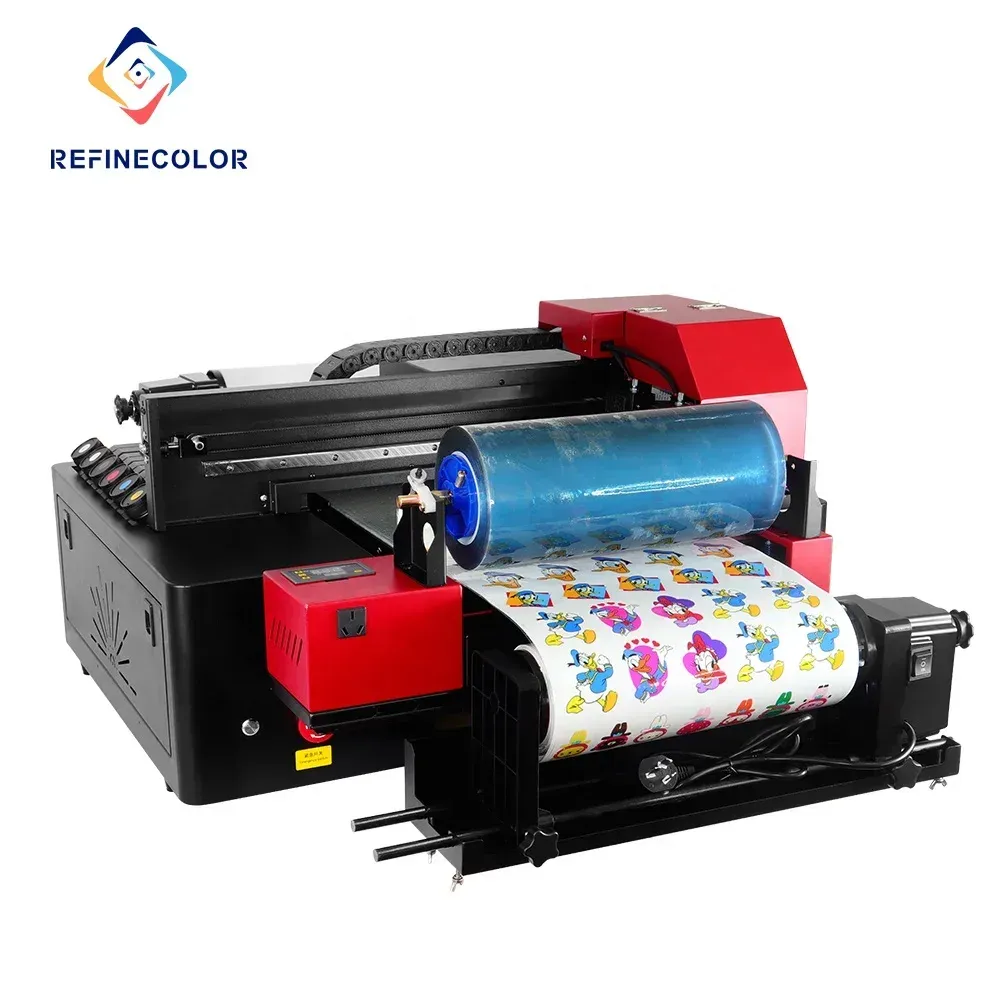UV DTF, or UV Direct to Film printing, is transforming the landscape of print technology by offering unprecedented quality and versatility in customization. As digital printing continues to evolve, UV DTF stands out for its ability to create vibrant, high-resolution prints suitable for a variety of materials such as textiles, plastics, and metal. This technology represents the future of print technology, allowing businesses to produce sustainable printing solutions with remarkable efficiency. Moreover, UV DTF systems enhance the creation of customized products that cater to diverse market needs, ensuring that brands can stand out in a crowded space. With its eco-friendly characteristics and rapid production capabilities, UV DTF is poised to redefine how we approach printing in various industries.
Known by various terms like UV Direct-to-Film, this innovative printing method is at the forefront of modern digital printing techniques. It allows for the seamless transfer of intricate designs onto diverse substrates, including but not limited to apparel and promotional items. This advanced process promises not only superb color fidelity but also longevity in the prints produced. As we delve deeper into the mechanics of this technology, it becomes evident that UV DTF is setting new standards in sustainable printing practices and customization possibilities. Understanding these nuances not only prepares businesses for the future but also offers insights into a competitive edge in the fast-evolving market.
What is UV DTF Printing Technology?
UV Direct to Film (DTF) printing is a specific digital printing technique that harnesses the power of ultraviolet light to cure inks as they are printed. This process results in high-quality graphics that are not only vibrant but also adhere well to a myriad of surfaces. UV DTF’s capability to print on diverse materials, ranging from textiles to plastics, has made it an essential approach in the modern printing landscape. By allowing for intricate designs with long-lasting durability, this technology has opened new avenues for graphic artists and businesses alike.
Furthermore, the process of UV DTF printing includes a unique step involving the application of a primer to enhance the ink’s adhesion to surfaces. This feature sets it apart from traditional printing methods, which often struggle with certain substrates. The convenience and versatility of UV DTF technology make it a significant player in the evolution of digital printing, paving the way for further innovations in customized products and sustainable printing solutions.
Benefits of UV DTF Compared to Traditional Printing Methods
One of the primary benefits of using UV DTF printing technology over traditional methods lies in its flexibility. Unlike conventional printing techniques, which are often limited to specific materials or require intricate setup processes, UV DTF can switch between various substrates seamlessly. This flexibility allows businesses to cater to a broader range of custom products, meeting diverse consumer demands with ease.
Additionally, UV DTF is distinguished by its efficient production speed. The direct nature of the printing process eliminates many of the time-consuming steps typically involved in screen printing or direct-to-garment methods. As a result, businesses can quicken their turnaround times while maintaining exceptional print quality, making it an ideal choice for promotional items and customized apparel that require rapid production cycles.
The Versatile Applications of UV DTF Printing
The versatility of UV DTF printing is evident across multiple industries, demonstrating its broad applicability in the marketplace. In the realm of apparel production, UV DTF technology allows for the creation of custom garments that feature intricate designs. Fashion brands have adopted this method due to its capacity to create bold, detailed prints that withstand the test of time and wear, establishing a new standard for high-quality fashion items.
Moreover, the promotional products sector has embraced UV DTF technology to produce items like mugs, badges, and keychains with vivid graphics. These personalized products serve as effective marketing tools, enhancing brand visibility while catering to the unique requests of individual customers. The ability to provide customized solutions rapidly and efficiently positions UV DTF as a significant force in promotional marketing.
Future Growth and Market Trends for UV DTF
The UV DTF printing market is poised for remarkable growth, buoyed by increasing consumer demands for customization and sustainability. According to market research forecasts, the sector is expected to see a compound annual growth rate of about 10% through 2027. This surge is attributed to businesses recognizing the potential and advantages of UV DTF technology in delivering superior quality prints that adapt to contemporary trends in digital printing.
As the demand for unique, tailor-made products rises, industries are shifting towards UV DTF to fulfill these requirements. Companies are investing in advanced UV DTF printing equipment that can accommodate diverse materials and applications. This proactive adaptation aids in not only meeting consumer preferences but also positioning businesses favorably in a competitive landscape driven by innovation and excellence.
Challenges Facing UV DTF Technology Implementation
Despite the numerous benefits offered by UV DTF technology, its adoption is not without challenges. One notable obstacle is the initial investment required to acquire specialized printing equipment. The costs associated with setting up UV DTF printing capabilities can deter small businesses from entering the market, creating a barrier to widespread adoption and innovation.
Another significant consideration is the complexity of maintaining UV DTF printing systems. Regular upkeep is essential to ensure optimal performance and continuity of high-quality print output. Additionally, businesses may need to invest in training personnel to operate these advanced printing technologies effectively. However, with advancements in the technology and increased availability of resources, these challenges are likely to diminish over time.
Embracing Sustainable Practices with UV DTF Printing
As environmental awareness continues to grow, UV DTF printing aligns well with sustainable practices, making it an appealing option for eco-conscious businesses. The UV inks used in DTF printing are known for producing fewer volatile organic compounds (VOCs) compared to traditional printing inks. This reduction in emissions contributes to more environmentally friendly production processes, promoting sustainability within the printing industry.
Additionally, UV DTF technology offers efficient material usage, allowing printers to minimize waste. By printing directly onto films and transferring designs with precision, businesses can reduce the leftover materials that often occur in traditional printing methods. This focus on sustainability not only enhances the reputation of printing companies but also satisfies consumer demand for eco-friendly products, allowing brands to build loyalty and differentiate themselves in a competitive market.
Frequently Asked Questions
What is UV DTF printing and how does it work?
UV DTF printing, or UV Direct to Film printing, is a modern digital printing technique that uses UV inks to print vibrant designs onto a film. This film can then be transferred to various surfaces, including textiles and plastics, using heat and pressure, resulting in durable and high-quality prints.
What are the benefits of using UV DTF technology for customized products?
The benefits of UV DTF technology for customized products include exceptional print quality, durability, and the ability to print on a wide range of materials. It enables businesses to create intricate designs that last longer, making it ideal for promotional items and personalized merchandise.
How does UV DTF compare to traditional printing methods?
UV DTF printing offers several advantages over traditional methods like screen printing, including faster production speeds, higher print quality, and greater flexibility in printing on both rigid and flexible surfaces, along with eco-friendly ink options that reduce VOC emissions.
What industries are adopting UV DTF printing technology?
Industries such as apparel production, promotional products, and signage are increasingly adopting UV DTF printing technology due to its versatility and ability to produce high-resolution graphics that meet the needs of modern consumers.
What trends are shaping the future of UV DTF printing in the market?
The UV DTF market is expected to grow significantly, driven by rising demand for customized products and the adoption of versatile printing technologies. Innovations from leading companies are expanding material compatibility and enhancing print quality, further solidifying UV DTF’s role in the future of print technology.
What challenges should businesses consider when implementing UV DTF printing?
Businesses looking to implement UV DTF printing should consider initial investment costs, ongoing maintenance requirements, and the need for skilled operators. While these challenges exist, advancements in technology are expected to make UV DTF more accessible and efficient.
| Key Points | Details |
|---|---|
| What is UV DTF? | A modern digital printing technique using UV inks to create high-quality prints on various surfaces. |
| Applications and Versatility | Widely used in apparel production, promotional products, and signage, making it suitable for various industries. |
| Advantages Over Traditional Methods | Includes flexibility, speed, print quality, and eco-friendly characteristics. |
| Market Trends | Expected CAGR of 10% through 2027, driven by demand for customization and versatile printing technologies. |
| Industry Adoption | Leading companies like Epson and Roland DG are advancing UV DTF technologies for broader applications. |
| Challenges | Initial investment costs, maintenance complexity, and the need for skilled personnel. |
Summary
UV DTF printing signifies a transformative leap in print technology, offering remarkable customization and environmental sustainability. This advanced printing method is not only versatile across various applications but also provides high-quality outputs that meet the modern consumer’s demands. As the technology continues to evolve, its integration in various industries reaffirms its role in shaping the future of printing. Companies leveraging UV DTF can enhance their competitive edge while fulfilling the growing need for personalized products in an environmentally conscious market.



